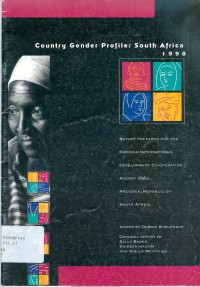
Text
Country gender profile: South Africa 1998
This Country Gender Profile of South Africa was commissioned by the Swedish International Development Co-operation Agency (Sida), Pretoria. It is one of a range of initiatives on the part of Sida to promote gender equality within its development cooperation programmes, a goal adopted in 1996, following the Beijing Conference (Sida, 1997a). Sida’s Action Plan for Gender Equality states that ‘Women and men shall enjoy equal rights, obligations and opportunities in all sectors of society. For equality to be attained, sharing of both power and responsibility between men and women is required’ (ibid.). The focus has shifted from attention to women, to ‘women and men’ and the relations between them. Furthermore, efforts to achieve equality are now ‘mainstreamed’ across Sida’s programmes, i.e. they should permeate Sida’s work at all levels, although women may still require special support to build their capacities (ibid.). The case for a focus on gender relations and inequality, rather than women, is particularly clear in the South African context. Given the intersections between race, class and gender oppression, a strategy which focuses on women to the exclusion of their social, political and economic relations with men is unlikely to succeed in South Africa. Since coming to office in 1994, the Government of South Africa has made strong and legally binding commitments to uphold and promote gender equality and has established a comprehensive national machinery to implement and monitor these commitments. The emphasis on gender, rather than women, implies the need to develop effective linkages between gender and other forms of inequality through concerted policy efforts. The immediate purpose for commissioning this Country Gender Profile is to provide an understanding of gender inequality issues in South Africa as an input into the process of developing a new country strategy for Sida’s development co-operation from 1999. While the initial audience for the report is the personnel of Sida, it is intended that it should have wide circulation and act as a resource for people within as well as outside South Africa concerned with gender inequality. A shorter, popular version of the profile has also been prepared for distribution across a wider, nonspecialist audience.
Availability
| KP.II.000280 | KP.II BAD c | My Library | Available |
Detail Information
- Series Title
-
-
- Call Number
-
KP.II BAD c
- Publisher
- Pretoria : Swedish International Development Co-operation Agency (SIDA)., 1998
- Collation
-
iii, 32 hal ; 30 cm
- Language
-
English
- ISBN/ISSN
-
-
- Classification
-
KP.II
- Content Type
-
-
- Media Type
-
-
- Carrier Type
-
-
- Edition
-
-
- Subject(s)
- Specific Detail Info
-
-
- Statement of Responsibility
-
-
Other version/related
No other version available
File Attachment
Comments
You must be logged in to post a comment
 Computer Science, Information & General Works
Computer Science, Information & General Works  Philosophy & Psychology
Philosophy & Psychology  Religion
Religion  Social Sciences
Social Sciences  Language
Language  Pure Science
Pure Science  Applied Sciences
Applied Sciences  Art & Recreation
Art & Recreation  Literature
Literature  History & Geography
History & Geography